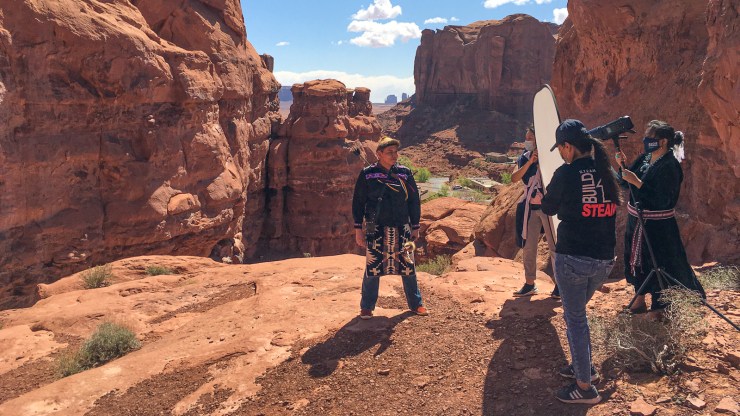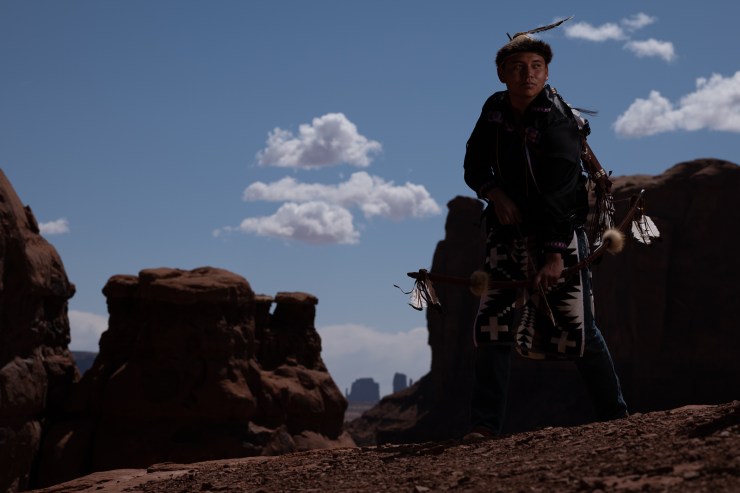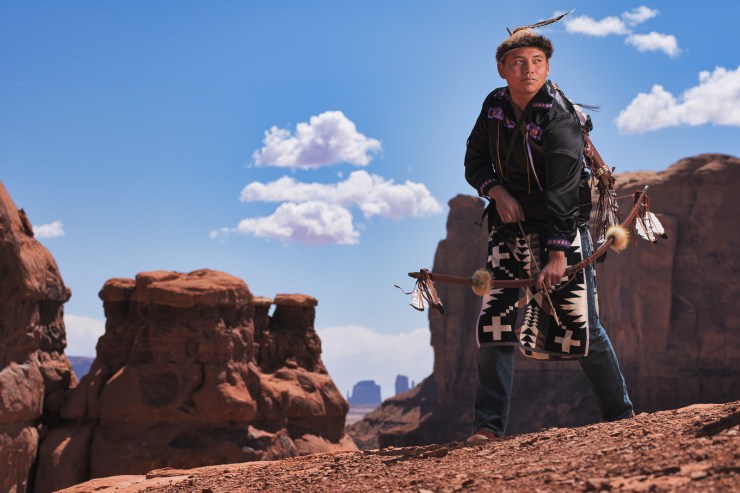The other day, I found myself in Monument Valley photographing a bunch of dancers. Of course, I was there at sunrise, which lasted for two hours and bathed the entire valley in beautiful light so I could leisurely make artful pictures to my heart’s content.
Psych! We actually arrived on site when the sun was already way up, and then it climber higher while the dancers got dressed and we hiked to the location. Things never go as well as I’d hope for these things, but the dancers still expect terrific photos.
Use high-speed sync for portraits when the sun is high but you still need directional light.
What is high-speed sync?
High-speed sync (HSS) allows your flash to light the scene even when the camera’s shutter speed is faster than the x-sync speed, or flash-sync speed. Most cameras have a flash sync speed between 1/160s and 1/250s. If the shutter speed is faster than that, then the flash doesn’t illuminate part of the subject. Check out this article for a deeper explanation.
But there are many times when you simply want/need a faster shutter speed. If your flash and trigger are capable of high-speed sync, then you can turn up the shutter speed and still get flash illumination.
Normally, the flash fires very brightly for a very short time. HSS makes the flash fire less brightly for a longer time. Let’s say the flash normally fires at full power for 1/1000s and gives you an aperture of f/5.6. Using HSS, it might fire for 1/500s and yield f/2.8. (These figures are just examples — I have no idea what actual numbers could be.) This might mean that if your shutter speed is 1/1000s, then the whole frame is still illuminated with strobe light because the flash (1/500s) is on longer than the shutter is open (1/1000s).
The trade-off is that the flash is much less bright when using HSS. So you must put the light closer to the subject. Or open the aperture. Or turn up the ISO. In this case, I purposely underexposed the whole picture.
If you use speedlights from your camera’s manufacturer, they are often capable of flashing many bursts as the shutter travels across the sensor. But most non-speedlights don’t have that capability and rely on HSS instead.

The settings
Let’s look behind the scenes in the picture above. First of all, there’s a bunch of buildings on the valley floor, which ruins the feeling of isolation I was going for. So, I had to get the camera down low. I used an 85mm lens to create a fairly tight frame and to focus on the archer.
I needed enough depth of field to identify the place — we need to see the Mittens in the background to know it’s not just any old red rock place — so I stopped the lens down to f/6.3.
The x-sync speed for my Lumix S1 is about 1/320s, but even at ISO 50, that was too bright and the clouds were blown out. So I increased the shutter speed to 1/640 and that did the trick. But now my subject was too dark with the sun high at 11 a.m.
The lighting
I fired the flash (Godox AD600Pro) through a huge diffuser to make it softer. My assistants held the diffuser instead of my favorite white umbrella because it was super windy and the umbrellas would have flown away.
With the flash at the subject’s head height, the light on his face is bright, then falls away toward his feet so they aren’t as bright. The flash is also positioned just a little closer to the camera than the sun’s light so that it’s not totally unbelievable that this is all available light.

This is the picture right out of the camera. It’s very dark, but the important thing is that it’s equally dark. The flash power was set at 1/2, and I could have gone up to 1/1, which is twice as bright. But at 1/2 power his face is lit about the same as the surrounding rocks, which helps it look believable.
Knowing I could brighten the whole thing all at once on the computer, I called it good and moved on to photographing the next dancer.
This is my usual soapbox about knowing what your software can do
I knew my software could handle this file, so I walked away excited. I’ve tried several different things and methods, and I’m still working on it. Here’s a version I like right now. I used LuminarAI to do all the finishing.

High-speed sync let me make this with the depth of field I wanted and the right brightness in the camera. I would have needed ND filters to use 1/320s without the flash’s HSS. Check and see if your flash and trigger can do high-speed sync. Then go practice using it so you’re ready in case you happen upon dancers on a cliff top at noontime.
Portrait Tips come out each week, and you can see them all right here.
Tell your story with the second annual Visual Storytelling Conference!
Experience four days of interactive, online training sessions featuring a range of educational content with experienced photographers and content creators. This free event kicks off with a series of technical boot camps to build essential skills, followed by live, online sessions on photography, video, business and social media. Join live from March 10-13, 2022!
